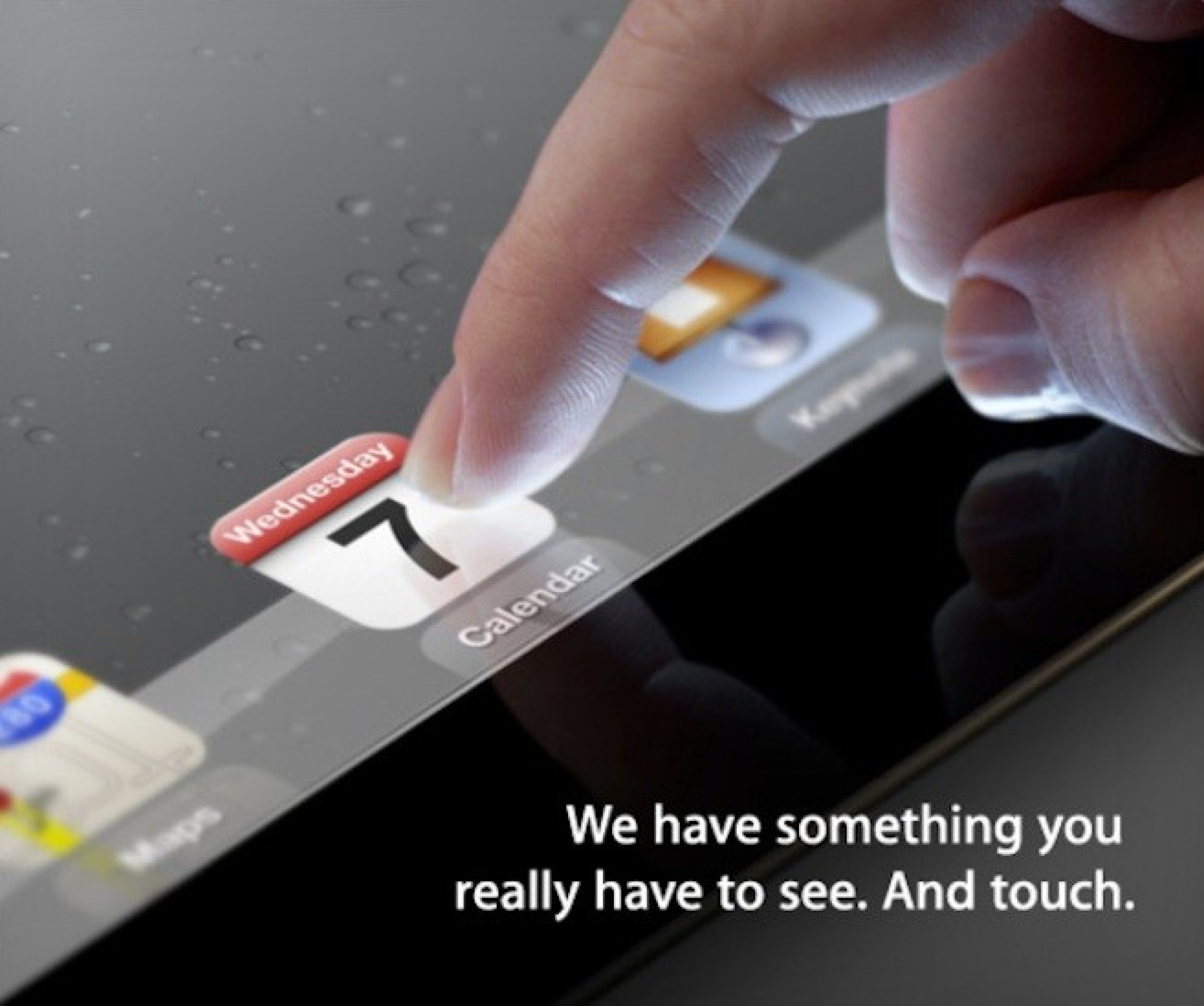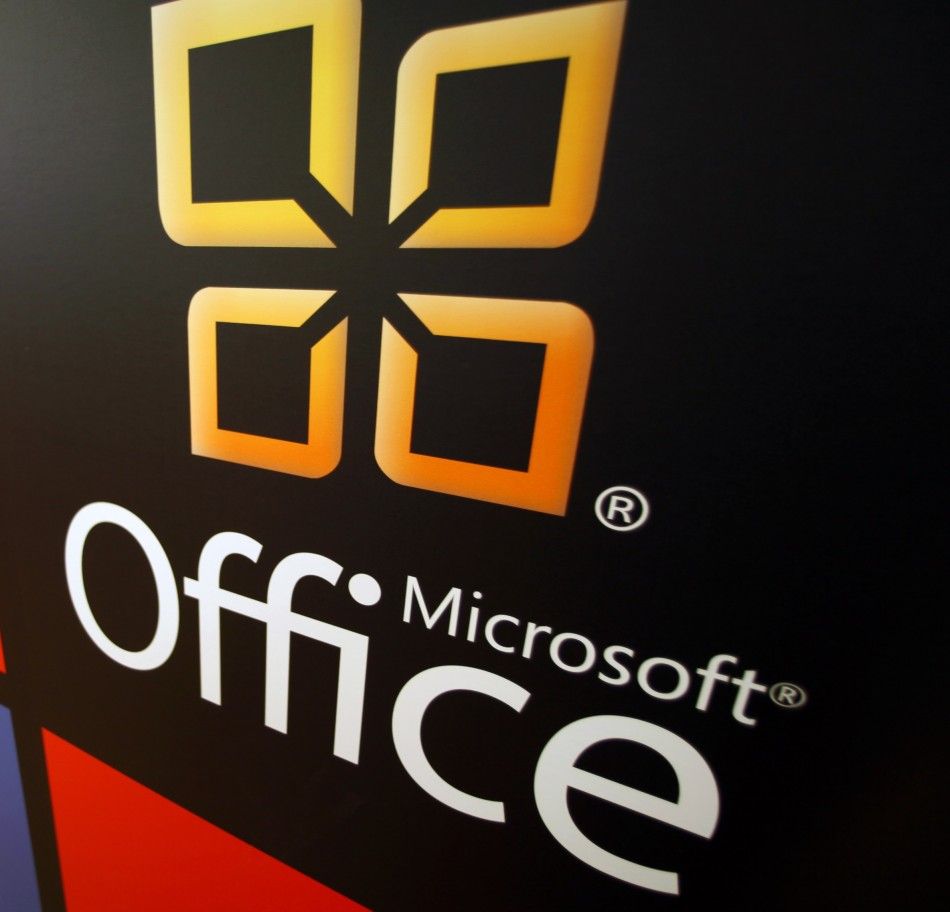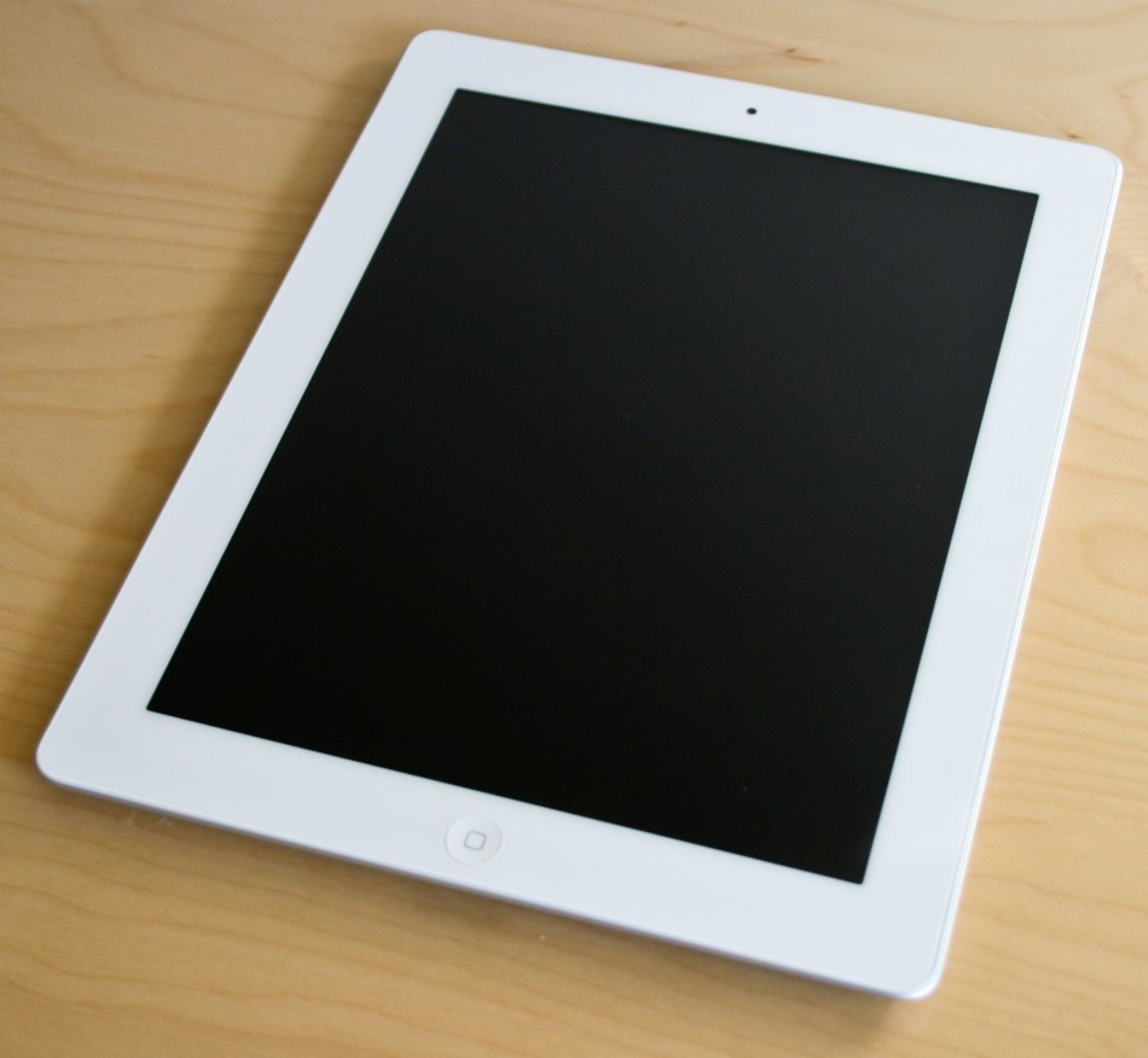Apple iPad 3 Release: 5 'Insanely Great' Launch Rumors, Features [PHOTOS]
In a few short days, Apple will finally unveil its next-generation iPad -- presumably called iPad 3 -- on Wednesday, March 7 in San Francisco. The Cupertino, Calif.-based company released invitations last Tuesday for the big product event, which will be held in the Yerba Buena Center for the Arts, Apple's preferred location for big events like these, according to AllThingsD's John Paczkowski.
Apple included a single message in its invitation: We have something you really have to see. And touch.
The iPad 3 is said to feature an improved camera, a bigger battery, and a dual-LED backlit system to power an 2048 x 1536 true HD display that looks, according to a source who spoke to The New York Times, truly amazing. Apple's dual-LED solution makes the iPad's screen noticeably brighter, but it also apparently solved several puzzling issues with heat dissipation and battery consumption.
But besides the iPad itself, what else can be expected at the March 7 event? Apple loves big surprises, and there's a great chance that the iPad 3 unveiling will also showcase some new, unexpected products and services. Here's what Apple might have in store for fans come Wednesday.
Microsoft Office for iPad
Microsoft and Apple have always been considered rivals, but there's a great chance Microsoft could use Apple's March 7 platform to announce its award-winning Microsoft Office software for the portable iPad.
In November 2011, Rupert Murdoch's tablet-only digital magazine The Daily discovered that Microsoft was planning to build a version of Microsoft Office for the iPad. On Feb. 21, sources told The Daily that the Microsoft Office app would soon be submitted to Apple for approval in the App Store. The app could arrive in early March, would be just in time for Apple's iPad 3 unveiling.
Microsoft already has several apps available on the iPad and iPhone, including Bing, MSN OnPoint, MSN Onit, Windows Live Messenger, Wonderwall, and Microsoft Tag. However, Microsoft's Office suite, which includes Microsoft Word, PowerPoint, Excel, and Outlook, has been the company's most successful software platform by far. Business Insider believes Microsoft Office earned more than $15 billion in revenue in 2011.
Files made in Word, Excel, or PowerPoint can be both created and edited on a local desktop computer and online. If Microsoft ports the software suite to the iPad, it's possible that documents created in Microsoft Office apps could sync with Microsoft Office 2011 for Mac via iCloud. This would make creating and updating documents extremely easy to do.
The launch date for Microsoft Office for iPad is not yet known, but since the design team has reportedly wrapped the project, users could expect the app to debut in the coming weeks. If Apple times this right, Microsoft Office could be the One More Thing on the company's third-generation iPad, which is reportedly set to debut on March 7.
Siri on the iPad
While Siri was originally released on an iPhone, it could really make a name for itself on the iPad. More people own smartphones than tablets, but people approach iPads for business, education, and productivity purposes. Given that Siri is meant to boost one's production, helping the user schedule and remember meetings and become better organized, the technology, when paired for with iPad, has incredible potential.
In February, the Washington Post said the next-generation iPad would also feature Siri, the AI virtual assistant currently exclusive to the iPhone 4S that can write and send texts and e-mails, place calls, schedule meetings and reminders, play music, surf the Web, and answer complicated and context-sensitive questions.
Siri has grown considerably since it was an iPhone application. The Siri app, which similarly understood conversations with its user to provide accurate answers, was originally a spinoff of a project co-developed by SRI Ventures and the Department of Defense's innovation arm called DARPA, or the Defense Advanced Research Projects Agency. The project was called CALO, which stood for Cognitive Assistant that Learns and Organizes, and it was the largest artificial intelligence project in U.S. history, with DARPA investing $150 million into CALO over five years.
The project later raised $24 million in two rounds of funding, led by Menlo Ventures and Morgenthaler Ventures, and was launched as an iPhone app on Feb. 4, 2010. Apple quietly bought the app two months later for an undisclosed sum.
Siri on iPad could have a tremendous impact in education, particularly with children with learning disabilities. The iPad could read aloud a selection from a new iBooks textbook, or remind the student to study for an upcoming test. If a textbook doesn't answer the student's question, they could simply ask Siri, which could then search its own database or try a Web search.
New App Store
Despite the App Store's overwhelming success -- Apple recently celebrated its 25 billionth app download -- the platform is far from perfect. Apple touts more than 500,000 apps in its ever-growing App Store, which is bolstered by waves of third-party developers, but its immense scale is a double-edged sword. After browsing through categorized and featuring apps, how does one discover new apps to enjoy?
Apple has a solution, but it needed some outside help. That's why Apple bought Chomp, an app search and discovery platform. Bloomberg Businessweek believes the deal was worth about $50 million.
We buy smaller technology companies from time to time and generally don't comment on our purposes or plans, an Apple spokeswoman told Bloomberg.
Apple doesn't need to explain how it plans to use Chomp; the latest news solidifies rumors that Apple was ready to overhaul its iTunes and App Store platforms for the first time in about three years.
The new design is said to be even simpler and more user-friendly than the current design, said Mark Gurman, who originally reported the story on 9 to 5 Mac. Apple is working on ways to enhance the speed and efficiency of finding new content, such as songs, videos, and applications. The cornerstone element of Apple's new iTunes Store is interactivity. As Apple vaguely explained to a number of music labels and entertainment partners, Apple is looking to make the iTunes Store a much more engaging experience.
Chomp offers a variety of ways to discover great apps for the iPhone, iPad, and all Android devices, too. The site features pages for new apps, trending apps, apps on sale, and free apps of the day. Chomp also provides pages for the apps considered All-Time Greats, as well as those apps trending heavily on Twitter. At the bottom of the page, Chomp also suggests popular app searches for categories users may not know about, such as voice recording apps, or guitar apps, or system utilities apps.
With the acquisition of Chomp -- not just its technology, but its entire 20-person team -- Apple hopes to turn around its App Store and revamp its system for search and recommendations. Of course, Apple has the money to pull off such a feat; the company announced its best quarter in its 35-year history on Jan. 24, with net income of $13.1 billion on revenue of $46.3 billion. The company reported holdings of $100 billion in cash.
There's a high degree of likelihood that the revamped versions of the App Store and iTunes Store will debut on March 7, since Apple is also expected to unveil an upgraded mobile operating system, iOS 5.1, which could support HD videos and a new way to search for apps.
A Mini iPad
On Feb. 13, the Wall Street Journal reported on Monday that Apple is also testing an 8-inch iPad in its labs, which may or may not be introduced alongside the iPad 3 in March. The news aligns with an earlier report from Apple's Taiwanese supply chain, which said the Cupertino, Calif.-based company would release a second, smaller tablet in October. Older reports similarly stated Apple would release a 7.85-inch iPad after the iPad 3. That tablet would reportedly upgrade its hardware specs throughout the device, and come with killer applications to compete with Android or Windows-based tablets.
A smaller tablet would make sense for Apple, as more competitors like Amazon and Barnes & Noble look to break into the tablet space with cheaper tablet offerings of their own, which both cost less than half the price of an iPad 2. Amazon's Kindle Fire measures 7 inches and costs $199. Barnes & Noble's Nook Tablet also measures 7 inches, but costs $249.
Apple experienced great success by releasing different shapes and sizes of its iPod music player; it's totally possible the company could replicate this formula with their tablets, too.
The tablet market, which was virtually non-existent prior to 2010, has become extremely popular in the last two years. Yet, people don't want tablets; they want iPads. According to market researcher IDC, the Apple iPad represented roughly 62 percent of all global tablet shipments in the third quarter of 2011.
Building a smaller tablet, however, would be going against the will of Steve Jobs, who said in October 2010 that the iPad's current 9.7-inch size was the minimum size required to create great tablet apps.
There's a great chance that Apple will release an 8-inch iPad, but it's unlikely that the tablet will arrive in March. Apple has enjoyed tremendous success releasing one product at a time -- as evidenced by the record-breaking sales of the iPhone 4S, which was not sold alongside another iPhone 5 like many speculated. If the Journal's reports are accurate, users could expect a mini 8-inch iPad in October or November.
A New Apple TV
Starting in January, reports surfaced that Apple was pulling its Apple TV set-top device from big box retailers like Best Buy and Amazon. Retailers still currently list the Apple TV as out of stock, and with Apple taking its time to refill orders, there's a great chance the March 7 event will also see a new Apple TV release alongside the new iPad 3.
The new Apple TV will reportedly feature the newest version of Bluetooth, called Bluetooth Smart (4.0). Apple previously integrated Bluetooth Smart into its new iPhone 4S, and has also added the function to the latest iterations of the MacBook Air laptops and Mac Mini computers. Leveraging Bluetooth 4.0 technology, Apple could potentially implement motion-sensitive controls and even Siri onto its TV platform.
Bluetooth Smart devices are designed to gather a specific type of information - are all the windows on my house locked, what is my insulin level, how much do I weigh today? - and send it to a Bluetooth Smart Ready device, Bluetooth wrote in a press release. Examples include heart-rate monitors, blood-glucose meters, smart watches, window and door security sensors, key fobs for your car, and blood-pressure cuffs-the opportunities are endless.
By integrating IEEE 802.11 a/b/g and single-stream 802.1 n (MAC/baseband/radio), as well as an FM radio receiver and transmitter, Bluetooth Smart can sync with wireless technologies, such as Apple TV, in about 6 milliseconds -- almost instantaneously. If Apple can find a way for Bluetooth Smart to get along with Apple's virtual assistant Siri, the two might both appear in the upcoming version of Apple TV.
The almost-instant connection achieved by Bluetooth 4.0, which can also leverage the gyroscopes and accelerometers within the iOS devices, also opens up the potential for the iPhone, iPad and iPod Touch to become remote controls and even game controllers. For instance, if you play a driving game and you turn your phone, the car on the screen may be able to mirror the motion. It's also possible that with the iPad 3's new display, Apple TV games could also be mirrored and played directly on the device as well.
The low latency connection of Bluetooth 4.0 is important for gaming, but it should also reduce the lag experienced in the Airplay mirroring feature in iOS 5, which shows any image on an iPhone or iPad on the Apple TV. Bluetooth 4.0 could also be the key to the completely interconnected system of Apple devices, which was outlined in Walter Isaacson's biography of the company's late founder Steve Jobs.
I'd like to create an integrated television set that is completely easy to use, Jobs told Isaacson. It would be seamlessly synched with all of your devices and with iCloud. It will have the simplest user interface you could imagine. I finally cracked it.
Jobs' goal was to reduce the amount of clutter in the TV watching experience, namely in the number of remotes needed to control the cable channels, as well as peripherals like DVD players and video game systems. Bluetooth 4.0, when used with Apple's iOS devices, could eliminate the need for separate TV and DVD remotes and combine all television needs into a simple interface.
But even if a simple Siri interface doesn't appear in the next Apple TV, there's a great chance Apple will upgrade the set-top platform to be compatible with 1080p HD. Starting late last year, Apple reportedly asked several movie studios to submit content to the iTunes Store in 1080p.
Thus far, 1080p HD content has largely eluded users of Apple products, with HD versions of videos on the company's digital download service maxing out 720p (1280 x 720) and chief executive Steve Jobs balking at adoption of Blu-ray on Macs due to licensing complications and other challenges that he said threatened to translate into a 'bag of hurt.' But that could begin to change later this year, as a handful of feature films being submitted to the iTunes Store for a release in the September and October timeframe are being sent with documentation for an optional 1920 x 1080 resolution, according to people familiar with the matter.
The iPhone 4S can already shoot movies and stills in 1080p HD, and the iPad 3 will also reportedly feature a 2048 x 1536 true HD display. It would only make sense to endow the Apple TV with next-level HD.
Apple has reportedly built two new chips -- a dual-core A5X chip and a quad-core A6 chip -- but in all likelihood, the A5X chip is reserved for the new Apple TV, while the heavy-duty A6 chip will power the bright and brilliant iPad 3.



© Copyright IBTimes 2024. All rights reserved.












